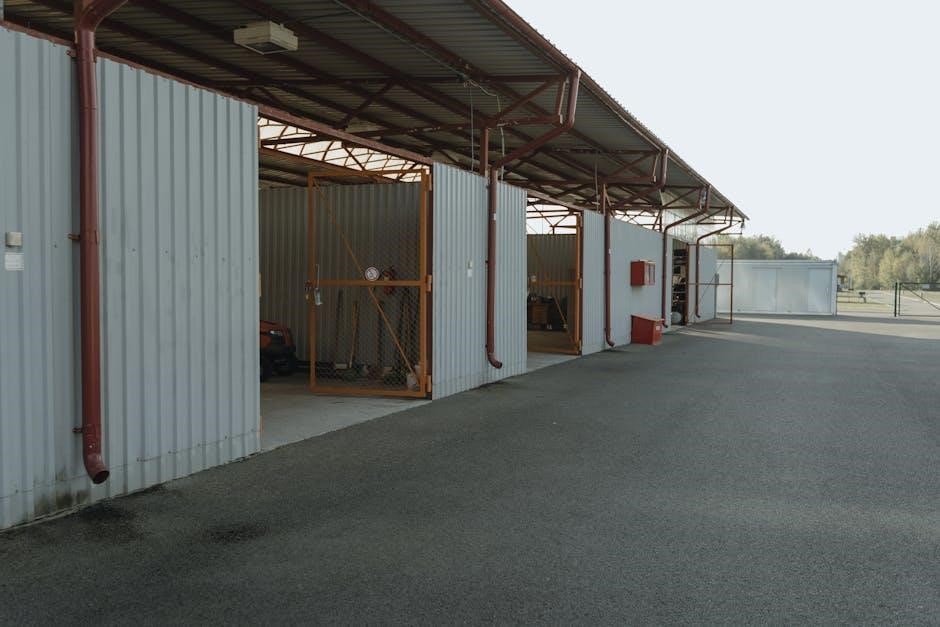Discovering a broken garage door spring can be frustrating, leaving you unable to open your garage door normally. This section outlines the necessary steps to safely address this situation and manually operate your door.

Safety Precautions Before Attempting Manual Operation
Before attempting any manual operation, prioritize your safety. Garage doors are heavy and potentially dangerous. Evaluate the situation and understand the risks involved with a broken spring before proceeding to avoid serious injury.
Importance of Assessing the Situation
Before attempting to manually open a garage door with a broken spring, a thorough assessment of the situation is crucial. This involves carefully observing the door, the springs, and the surrounding area for any visible damage or obstructions. Look for frayed cables, bent tracks, or anything that could further complicate the process or pose a safety hazard. It is essential to determine if the door is partially open or completely closed, as this will affect the approach you take.
Understanding the extent of the damage will help you anticipate potential challenges and prepare accordingly. Remember, safety is paramount, and a well-informed approach minimizes the risk of personal injury or further damage to the door. If anything seems beyond your capability, seek professional assistance.
Potential Dangers of a Broken Spring
A broken garage door spring presents several potential dangers that must be acknowledged before any manual operation is attempted. Garage door springs are under immense tension, and when one breaks, the stored energy can be released suddenly and forcefully, potentially causing serious injury. The door itself becomes significantly heavier and unbalanced, making it difficult and dangerous to lift.
Attempting to lift the door without proper precautions could lead to muscle strain, back injuries, or even being trapped under the weight of the door. Furthermore, if the door is not properly secured, it could unexpectedly slam shut, causing further damage or injury. It is crucial to be aware of these risks and take appropriate safety measures, or ideally, seek professional assistance. Remember, safety is paramount.

Disengaging the Garage Door Opener
Before attempting to manually lift your garage door with a broken spring, it is crucial to disconnect it from the automatic opener. This ensures you are not fighting the opener’s mechanism.
Locating the Emergency Release Cord
The first step in disengaging your garage door opener is to locate the emergency release cord. This cord is typically red and has a handle, often shaped like a T or a knob. It hangs down from the garage door opener mechanism near the door. The emergency release cord is a critical safety feature designed to disconnect the door from the opener during power outages or when the spring is broken. Carefully examine the area around your garage door opener motor; the cord should be easily visible. If you have difficulty finding it, consult your garage door opener’s manual for specific instructions and location details. Ensure you have a clear view of the cord and its handle before proceeding, as you will need to pull it firmly to disengage the opener.
Pulling the Release Cord Correctly
Once you have located the emergency release cord, the next step is to pull it correctly to disengage the garage door from the opener. Before pulling, ensure that the garage door is fully closed, if possible. This will prevent the door from suddenly dropping if the spring is broken. Grip the handle of the release cord firmly and pull it down and back towards the opener motor. You should hear a click, indicating that the door has been disconnected. After pulling the cord, test the door by attempting to lift it manually. If it moves freely, the disengagement was successful. If not, try pulling the cord again with more force. Be cautious and aware of the door’s weight, especially if you suspect a broken spring, as the door may be much heavier than usual. Disconnecting the garage door opener is a key step toward safe manual operation.

Manually Lifting the Garage Door
After disengaging the opener, carefully attempt to lift the garage door. Due to the broken spring, the door will be heavy, so proceed with caution and consider seeking assistance to lift the door.
Assessing the Door’s Weight
Before attempting to manually lift a garage door with a broken spring, it’s crucial to accurately assess its weight. A functional garage door spring system balances the door’s weight, making it manageable for the opener or manual operation. However, when a spring breaks, this balance is lost, and the door becomes significantly heavier. This increased weight poses a significant risk of injury if not handled correctly.
Try to lift the door a few inches to get a sense of how much force is needed. If it feels excessively heavy or if you struggle to lift it even slightly, it’s a clear indication that the door’s weight is more than you can safely manage alone. In such cases, do not attempt to lift the door further. Enlist the help of another person to assist or, more preferably, contact a professional garage door service.
Lifting Techniques and Assistance
Once you’ve assessed the door’s weight and determined that you can safely proceed, employ proper lifting techniques to minimize the risk of injury. Stand close to the door, keep your back straight, and bend your knees. Grip the door firmly at a comfortable height, ensuring your fingers are clear of any pinch points or seams.
Lift with your legs, not your back, and maintain a steady, controlled motion. Avoid jerky movements or sudden bursts of force. If possible, have someone assist you in lifting the door. Coordinate your efforts to lift evenly and smoothly. If the door feels too heavy or unstable, stop immediately. Do not attempt to force the door open, as this could cause further damage or injury. Remember, safety is paramount.
Securing the Open Garage Door
After manually lifting your garage door with a broken spring, it’s vital to secure it in the open position. This prevents unexpected closures and potential injuries or damages to property within the garage.
Using the Manual Lock
Once the garage door is manually lifted, engaging the manual lock is crucial for safety and security. Most garage doors have a slide-bolt lock located on the inside of the door. After lifting the door, carefully slide this bolt into the track to prevent the door from rolling down. Ensure the bolt is fully engaged in the track to provide a secure hold.
If your garage door doesn’t have a built-in manual lock, consider using a C-clamp or locking pliers to secure the door to the track. Position the clamp just below a roller to prevent movement. Double-check that the locking mechanism is firmly in place before leaving the door unattended.
Remember, with a broken spring, the door is unstable and could fall unexpectedly, so take all necessary precautions. This added security provides peace of mind while waiting for professional repairs.
Preventing the Door from Closing Unexpectedly
With a broken spring, a garage door becomes incredibly unstable and poses a significant safety risk. The weight of the door is no longer balanced, meaning it can crash down with little to no warning. To prevent unexpected closure, after manually lifting the door, use the manual lock, if available, to secure it in the open position.
In addition to the manual lock, strategically place sturdy objects, like a 2×4 or metal bar, under the door to act as physical barriers. Position these supports on either side of the door to distribute the weight evenly. Make sure these objects are strong enough to handle the door’s weight and prevent it from suddenly dropping.
Always be aware of the door’s instability. Never stand directly underneath the door while it’s open, and keep children and pets away from the area until the spring is repaired by a professional. Remember that these are temporary safety measures.

When to Call a Professional
While manual operation is possible, it’s crucial to recognize its limitations. A broken spring is a serious issue. Therefore, contacting a qualified garage door technician is the safest course of action.
Recognizing Limitations and Risks
Attempting to manually operate a garage door with a broken spring carries significant risks. Garage doors can be incredibly heavy, and the springs are designed to counterbalance this weight. When a spring fails, the door’s full weight is no longer supported, making it difficult and dangerous to lift.
Trying to force the door open could result in personal injury due to the sudden release of weight or strain. Furthermore, attempting DIY repairs or forcing the door can cause further damage to the door, opener, or other components. It’s essential to acknowledge your limitations and prioritize safety.
If you experience difficulty or feel any resistance beyond what seems manageable, immediately cease the attempt and seek professional assistance. Remember, your safety and the integrity of your garage door system are paramount.
Importance of Expert Spring Replacement
Replacing garage door springs is a task best left to trained professionals due to the inherent dangers involved. Garage door springs are under immense tension, and improper handling can lead to severe injuries. Experts possess the necessary tools, knowledge, and experience to safely and efficiently replace the broken spring.
Furthermore, they can correctly assess the specific type and size of spring required for your door, ensuring proper balance and operation. Using the wrong spring can compromise the door’s functionality and create a safety hazard. A professional replacement guarantees the new spring is installed correctly, promoting the longevity and safe operation of your garage door system.
By entrusting this task to experts, you mitigate the risks associated with spring replacement and ensure the continued smooth and safe operation of your garage door.
